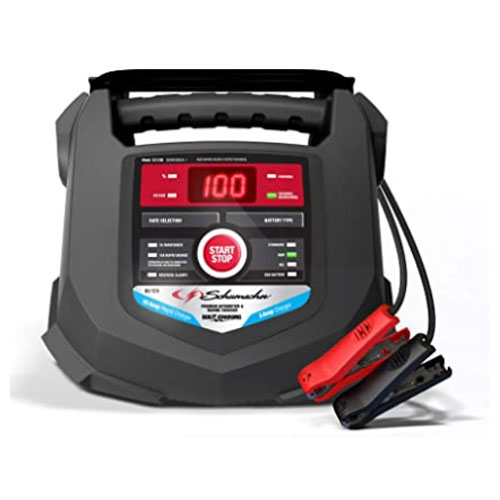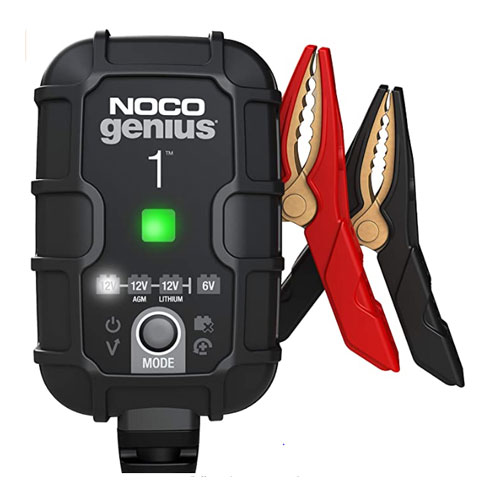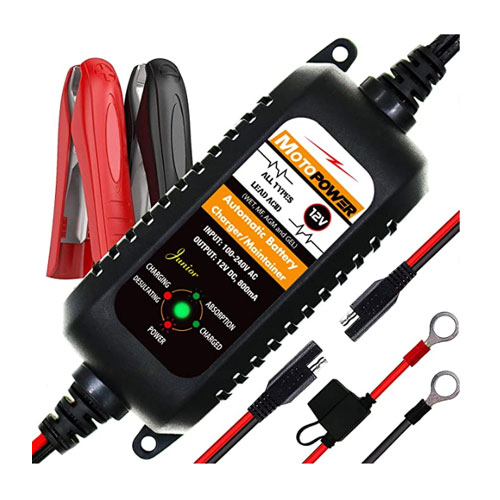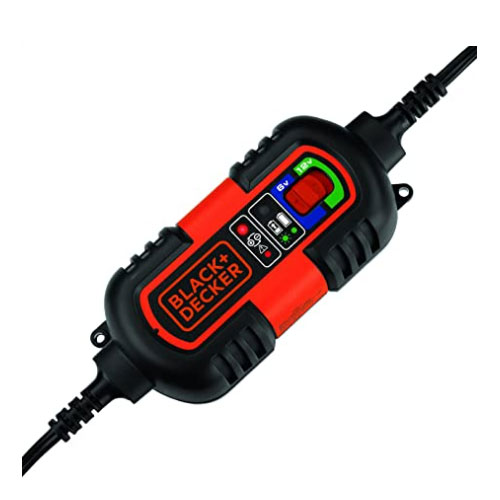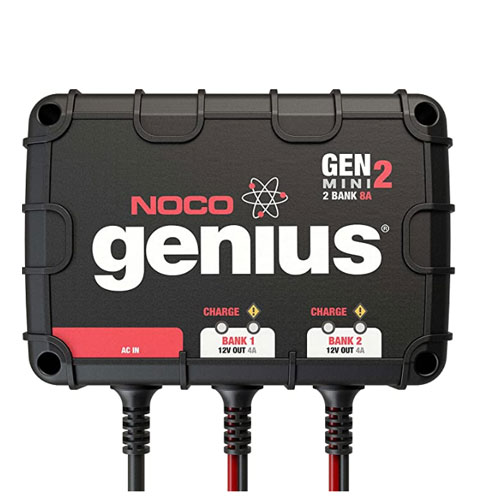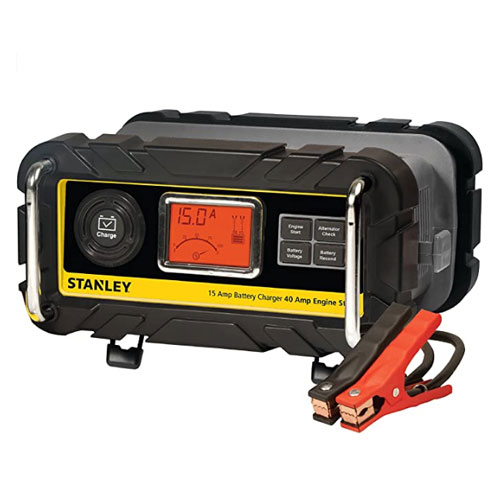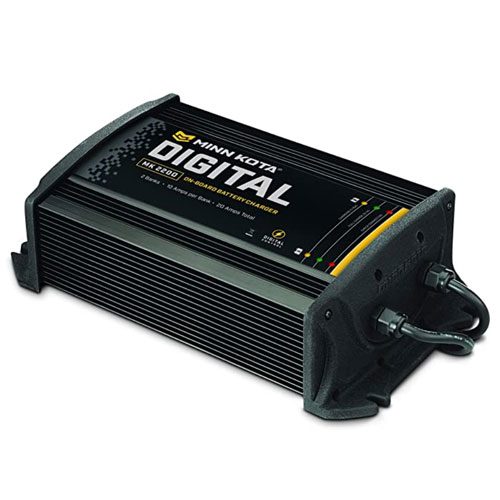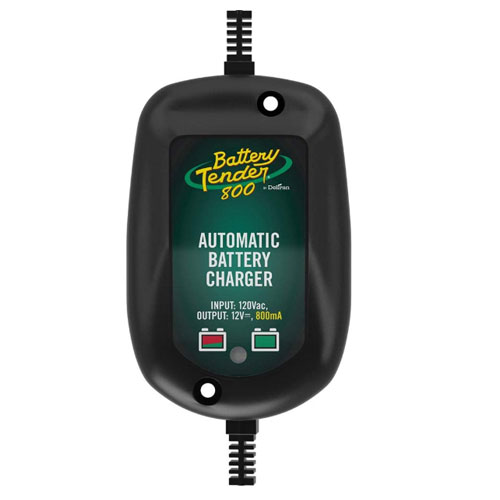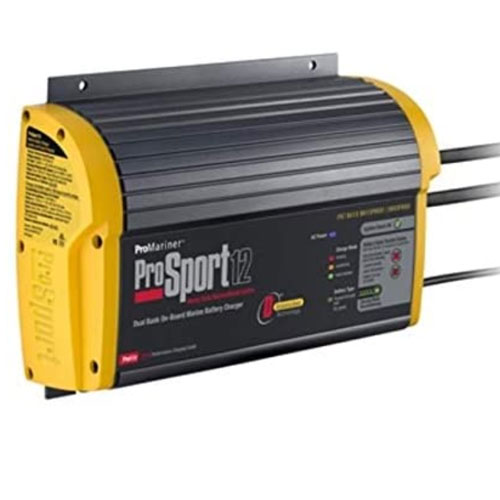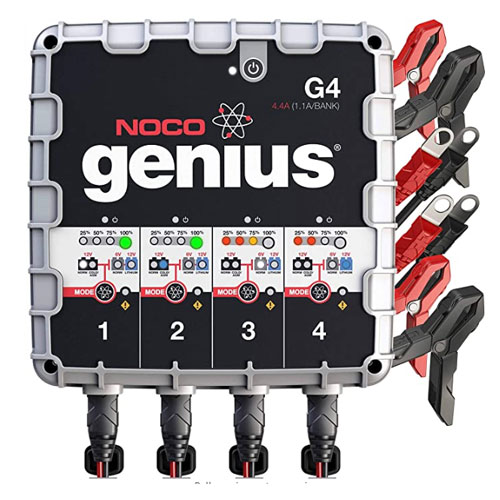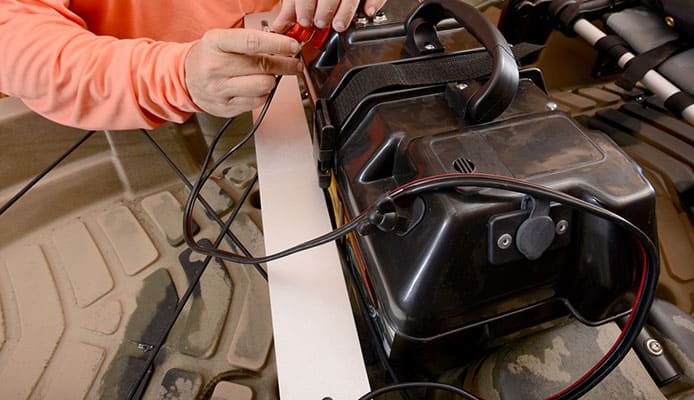
Best 12v Lead-Acid Marine Battery Charger

-
1.
-
2.
-
3.
-
4.
-
5.
Nothing shortens a battery’s life more quickly than having it without an onboard trickle charger. Before your boat’s battery dies in the middle of the sea, you should make sure that it has been properly charged by a battery charger. Given the fact that there are several types of batteries and all of them have different uses and require specific charging requirements, therefore, it is crucial to buy the best boat battery charger and make sure it can provide the correct charge at the right time.
Here at Globo Surf, we have looked at the boat battery charger reviews to make sure that we have the top-rated marine battery charger that will be the perfect fit for your boat. We explore the key features and answer the important questions to give you the information you need to choose the best marine battery charger
Best 6v And 12v Marine Battery Charger
Schumacher
- Stand Out Features - Why We Love It
- Has an automatic voltage detection feature to identify 6 and 12V batteries
- Displays charge percentage on a LED digital display
- Has an internal clamping protection
- You can charge your finished accumulators from less than 1 volt to 96%
Compatibility: Standard, AGM, gel, and deep-cycle batteries
Banks: 2bank battery charger
Weight: 3.07 pounds
Dimension: 9.96 x 4.29 x 10.03 inches
Best Marine Battery Charger For All Vehicles
NOCO Genius1 Fully-Automatic
- Stand Out Features - Why We Love It
- It even charges up to batteries that are dead
- It provides maintenance of your battery
- Compatible with all kinds of vehicles
- Precise charging thanks to the integrated thermal sensor
Compatibility: Lead-acid and lithium-ion batteries, including flooded, gel, and AGM
Banks: 2bank battery charger
Weight: 1.08 pounds
Dimension: 3.43 x 4.02 x 6.73 inches
Best 12v Lead-Acid Marine Battery Charger
MOTOPOWER Fully Automatic Marine Battery Charger
- What Makes This Boat Battery Charger Stand Out
- Increased battery performance due to Absorption Mode
- Has 7.5amp fuse system
- Charges flooded or sealed maintenance-free batteries
- Avoids excessive charge and discharge
Compatibility: 12V lead-acid batteries, including flooded or sealed maintenance-free batteries
Banks: 2bank battery charger
Weight: 10.4 ounces
Dimension: 4.10 x 2.00 x 1.50 inches
Best Off-Season Marine Battery Charger
Black+Decker Automatic Marine Battery Charger
- What Makes This Boat Battery Charger Stand Out
- Keeps AGM, GEL, and WET batteries at optimum capacity during the offseason
- Very simple to use and provides easy installation
- Protects against overcharge, reverse polarity, or short-circuit situations
- A drip charger with AC Low voltage compensation for batteries
Compatibility: 6 volt and 12 volt AGM, GEL, and WET batteries
Banks: 1bank battery charger
Weight: 1.25 pounds
Dimension: 5 x 3 x 8.9 inches
Best Waterproof Marine Battery Charger
NOCO Genius
- Stand Out Features - Why We Love It
- In the IP68 class, it is water-resistant and waterproof
- Ultra-safe, non-flammable, and temperature controlled
- Repairs accumulator chemistry and guarantees the long life
- Charges all types of lead-acid batteries from 20-120ah
Compatibility: Lead-Acid batteries from 20-120ah, including wet, gel, AGM, and deep-cycle batteries
Banks: 2bank battery charger
Weight: 5.8 pounds
Dimension: 7.9 x 2.2 x 5.5 inches
Best Powerful Marine Battery Charger
Stanley Bench
- Stand Out Features - Why We Love It
- Protects the accumulator and helps extend its life
- Automatically eliminates the problem of low voltage
- You can see whether the alternator maintains its charge level
- Its performance is 40 percent superior to other traditional chargers
Compatibility: AGM, GEL, or WET automotive or marine 12V battery
Banks: 1bank battery charger
Weight: 6.39 pounds
Dimension: 12.38 x 5.75 x 9.75 inches
Best Saltwater Marine Battery Charger
Boating Accessories New MINN KOTA
- Stand Out Features - Why We Love It
- Designed to help you stay in the water longer
- Saltwater tested and corrosion-resistant
- Offers a three-year warranty
- Chargers detect and adjust to ambient temperature changes
Compatibility: Lead-acid and AGM batteries
Banks: 3 bank battery charger
Weight: 11.02 pounds
Dimension: 7.48 x 11.5 x 3.98 inches
Best All-Conditions Marine Battery Charger
Battery Tender
- Stand Out Features - Why We Love It
- Designed to be water-resistant
- This very light charger is maintenance-free
- It can be easily mounted with the help of alligator clips and ring terminals
- It is protected from vibration and moisture
Compatibility: Lead-acid, flooded, or sealed maintenance free batteries (AGM and gel cell)
Banks: 1 bank battery charger
Weight: 1.92 ounces
Dimension: 10 x 4 x 10 inches
Best Multi-Battery Marine Charger
ProMariner
- Stand Out Features - Why We Love It
- Designed to be energy efficient to charge batteries in the maritime industry
- Ability to charge 100% of the batteries that are completely exhausted in about 4 hours
- Impressive digital lighting and display system
- Easy to install and connect
Compatibility: Wet cell, AGM, HP AGM, and optional Gel cell functionality
Banks: 2 bank battery charger
Weight: 5.9 pounds
Dimension: 7.2 x 2.8 x 9.9 inches
Best Digital Marine Battery Charger
NOCO Genius 4-Bank UltraSafe Smart Marine Battery Charger
- What Makes This Boat Battery Charger Stand Out
- Ensures battery life and year-round battery maintenance
- Includes spark-proof technology and reverse polarity protection
- It can keep your batteries charged all winter by staying in the winter
- Has high voltage charging capability
Compatibility: Lead-acid, Wet, Gel, AGM, HP AGM, and Lithium-Ion
Banks: 4 bank battery charger
Weight: 2.7 pounds
Dimension: 9.3 x 9.4 x 2.5 inches
How To Choose A Marine Battery Charger – Buying Guide
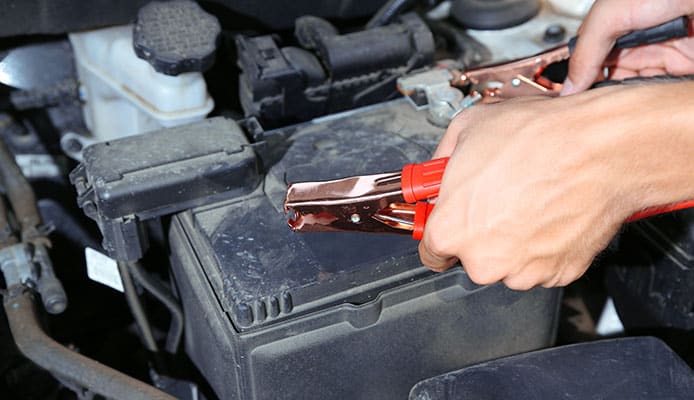
Voltage
It is important to make sure that the marine battery charger can provide the right amount of voltage for your battery. Marine batteries usually run off a 12V system, however, this might not always be the case as 24V and 48V systems are becoming more common. The battery should be capable of various charging powers and can charge at both 6V and 12V. There are battery chargers where you can switch between the two voltages automatically. It’s important to check your battery to ensure that the charger you are getting will be a suitable fit.
Type
There are many different types of batteries out there such as flooded lead-acid batteries, sealed lead-acid, AGM, gel, and lithium-ion options which have different charging requirements. Most of these marine battery chargers we have reviewed support several different battery types but you shouldn’t presume that your type is going to be covered. The best marine battery chargers have microprocessors that can read your battery type and adapt its amperage and voltage to meet the battery’s demands.
Durability
If you’re taking your battery charger on a boat with you, you need to have one with a higher level of durability. Being able to withstand shocks and having waterproof protection are also exceptional additional features. Others may want a much more sedate environment where they will be used to recharge the battery when the boat is not being used or trickle charge it during the offseason.
Safety
One of the most obvious criteria is the protection against reverse polarity which all battery chargers need to have to protect their users. Other key safety traits include having the right amount of fuses as well as protection from too much current, voltage, and temperature. It’s important to have these features especially considering that your battery charger will most likely be left alone for a long period. If a battery gets overcharged, it can release volatile gasses which can ignite, as well as cause the battery itself to crack, leak, or explode! Having a safe battery charger that will take care of your batteries is important as it will keep your batteries and your boat safe.
Charging Time
The charging time of your battery depends on the size of the battery as well as the type of battery. Type plays a huge role as each battery charger accepts a different kind of amperage so having a defined time for your battery charger depends on several different circumstances. The more powerful your battery charger, the more quickly it will charge your battery. This becomes especially important when trying to charge larger batteries, a small charger can still do the job, but it might just be an unreasonable amount of time. Having a more powerful battery charger will let you charge your battery back up to full in less time.
Battery Banks
If you have multiple batteries then it is better to have a battery charger that has numerous banks so that it can charge several batteries at the same time. This will come in handy especially for those that have both a deep cycle and a starter battery as well as for those who have a larger vessel with many different batteries. If you think you might want to add some extra power in the future then giving yourself the option of an extra bank might be wise.
Recovery Time
Recovery time is determined by your battery’s ability to recover its charge after it has been fully drained. Generally the higher the amperage that your charger can give, the quicker it recovers your battery. The importance of this depends on how often you use your battery and how much you use it. The best chargers fully recover your battery in just a few hours whereas others take a lot longer. If you will be using your boat for multiple days in a row then it is better to have a battery charger with a quick charging ability.
You might also like: Perfect Boat Switch Panels
On-Board Vs Portable Boat Battery Chargers
If you have a smaller vessel, having a portable model is ideal as you wouldn’t need the same level of power. If you have a larger boat with more than one battery, then getting an onboard charger is better as you will be able to charge many different batteries time and time again. This would allow you to have a constant power source so that you never run out of charge.
Another thing to consider is “how involved do you want to charge to be?” A portable unit needs to be connected to the batteries every time you use it. A built-in unit simply needs to be plugged in.
Size
Larger batteries are more powerful and offer more features such as a larger range of banks. You want to select a size that is going to be compatible with your boat and easy to store. If you have a portable battery charger then this will be much less of an issue as long as it’s light enough to be moved from one place to another.
Power Source
An onboard battery charger requires access to a shore power unit when you are docked up if you will be leaving it on the water overnight. If you’re the type of person who makes use of the boat for a day and trailers it back home, then this isn’t a requirement. This is also where portable chargers have their advantage as they can be powered up in the comfort of your own home.
FAQs
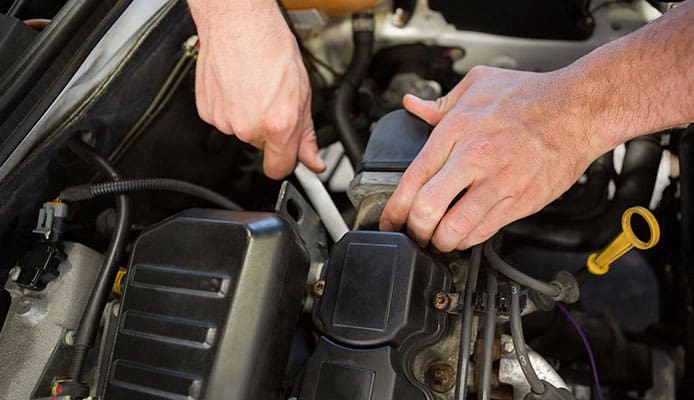
Q: Can I charge a deep cycle battery with a regular charger?
No, it is not convenient to charge a deep cycle battery with a normal charger. Here are some of the reasons:
- Deep cycle battery plates are much thicker than normal battery plates and sulfate formation is low. However, normal batteries have thin plates, and the amount of sulfate increases gradually.
- Deep cycle batteries hold a lot of power, expressed in the term Amp-Hours (ah) on the battery. The ability to hold a lot of amps means that it would just take too long to charge them with a conventional battery charger. If you have a 100ah Deep Cycle battery, it would take 50 hours to charge it with a conventional 2 amp charger, while a 20 amp charger could bring that battery up to speed in only 5 hours. As the battery nears completion in its charge, a proper marine battery charger will sense this and switch from Bulk charge to Float charge. This finishes the battery off in a safe manner. A conventional battery charger would simply overcharge the battery and cause damage.
Q: How do I choose an onboard battery charger?
When choosing an onboard battery charger, it is important to choose a device that is compatible with your battery. You have to consider important features such as type, input voltage, amp-hour capacity, and the environment you will be using the battery. The biggest killer of batteries is overcharging. If possible, an internal and intelligent battery charging and maintenance device should be preferred for such batteries. Charging time is a determining factor in this regard, as well. More discharged batteries or smaller alternators require more time for a charge.
Q: What is the best way to charge a deep cycle marine battery?
With a smart and dedicated marine battery charger. Deep cycle marine batteries are robust pieces of equipment that keep your boat working long after the motor is turned off and the input charge stops. They keep your lights on, your beer cold, and start the motor back up when you want to get out of there. Your batteries work hard and deserve a proper battery charger, like the ones we listed above.
Q: What Size Charger Do I Need for My Deep Cycle Battery?
The size and the type of your battery are two important factors as the more current you put into your battery the quicker it charges. There is little point in getting a heavy-duty charger if you only have a small battery. The total amperage that your battery can accept also depends on the size of the battery, expressed in the term Amp-Hours or ah on the battery. The speed that your battery can accept charge depends on the type of battery you have.
A flooded battery is generally the least efficient type and only accepts a charge rate of up to 25 percent of its capacity. A gel battery is a little bit better and accepts a charge rate of 30 percent. The most efficient battery is an AGM battery which can accept the highest amperage of the three and can take 40 percent of its capacity. If you’re looking for a quick charge, then look for a charger that has more amps listed in its output. If you get a great charger and have a flooded battery, then it won’t be able to charge as quickly if you put the same charger on an AGM battery.
Q: How Many Banks Should I Have On My Charger?
In simple terms, the number of banks refers to the number of separate battery groups that you can charge at the same time. If you have a smaller boat and only have one battery then you don’t have to worry about how many banks your charger has. The general rule is that you want to match the number of banks that your charger has with the number of battery banks that you have, whether that is one, two, three, or four. If you think you might expand your electronics then getting one more bank than you need at the moment will mean that you can be more prepared for the future.
Q: What Should I Do If My Battery Charger Overheats?
The best way to stop your charger from overheating is to buy a quality charger in the first place. The best chargers on the market have in-built safety systems that prevent them from overheating and have temperature controls that match them to their climate. A lot of marine battery chargers have microprocessors installed that can read what your battery needs. These battery chargers also detect when a battery is fully charged and switch from a full charging mode, also known as bulk charging, to float charge mode, which safely finishes off the battery's charging process.
Globo Surf Overview
Getting a top-rated marine battery charger means that you will be able to charge your batteries easily with a high level of safe performance. A battery is vital to your boating experience and hopefully, one of the battery chargers on our list is the one you are looking for.



